Barreling Through Bad Vibes at Paris Fashion Week
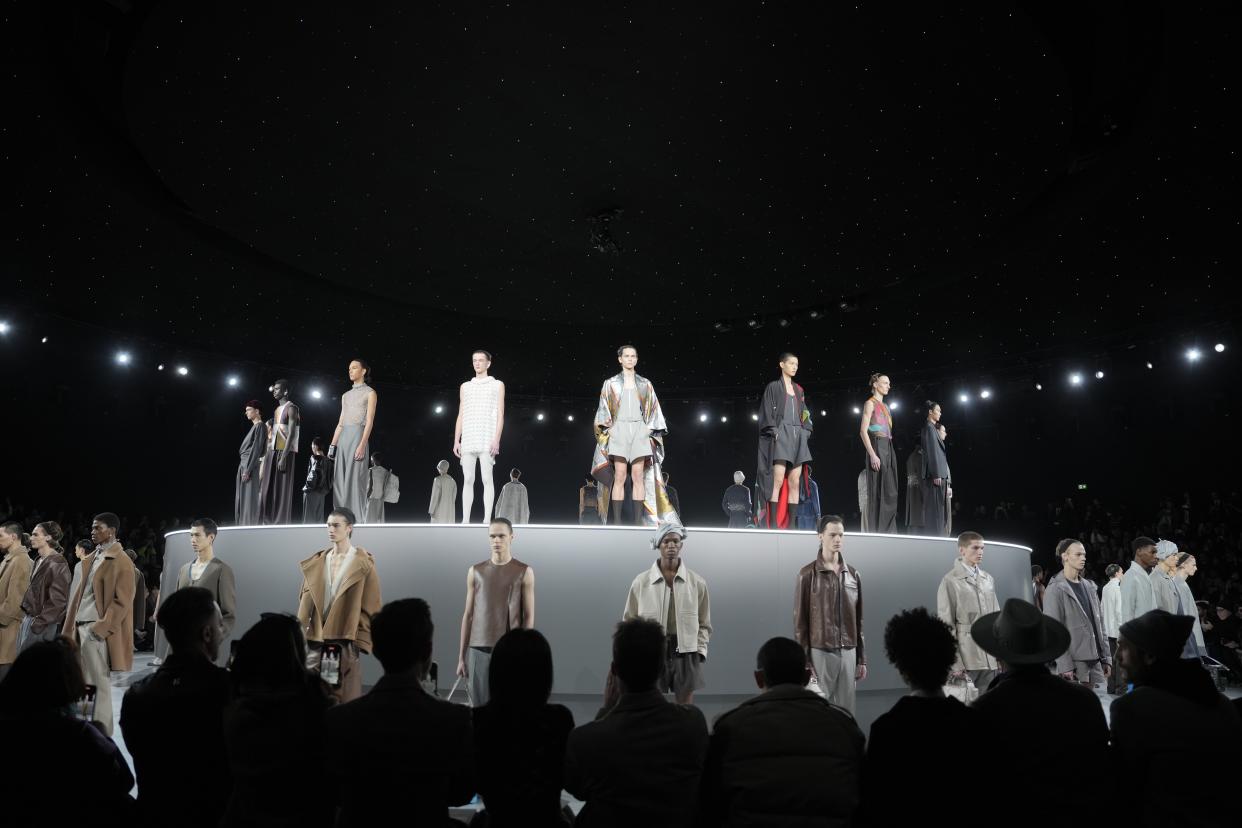
Swan Gallet / WWD / Getty Images
This is an edition of the newsletter Show Notes, in which Samuel Hine reports from the front row of the global fashion week circuit. Sign up here to get it in your inbox.
At this season’s men’s fashion shows, which started two weeks ago in Florence and culminated yesterday in Paris, only one thing was more ubiquitous than sweaters worn as scarves. (More on that later.) Everywhere I turned, I saw someone—editors, buyers, celebs, models—wearing knit jackets and hats from the Sacai x Carhartt WIP line. A PR rep who works with Sacai told me this wasn’t manufactured through a huge seeding campaign. It was a bona fide organic hit, one that speaks to how obsessed the fashion world is with Sacai right now.
Sacai is designed by Commes des Garçons alum Chitose Abe, who founded the brand in 1999. Abe is known for constructing clothing through hybridization, splicing the DNA of different garments together to make something totally new. Her recent runway shows have been excellent, but the brand still feels deeply underrated. Unlike some of the Paris headliners I covered this week, such as Louis Vuitton and Rick Owens (and even Amiri!), Sacai is never one of the big stories or most hyped shows. It doesn’t help that the brand is on the final day of the men’s shows, by which time the front-row crowd is long out of small talk and desperate to get off tour.
Abe, whose framework is wardrobe basics, doesn’t overpower her audience with glamor and luxury. She is more concerned with designing utilitarian fashion—conceptual clothes that elevate your daily life but don’t get in your way—hence her collaborations with the likes of Carhartt and Nike “I do think the brand has been underrated because it is functional, and function doesn't get a lot of pizazz in the fashion industry,” said my friend Steff Yotka, head of online editorial at SSENSE, who was wrapped in a large black Sacai x Carhartt duffle coat all week.
But in an industry that’s been drowned in pizazz and now faces a tough economic outlook, Abe’s approach is brilliant. On Sunday, she brought PFW home with an electrifying collection that jolted me out of my end-of-season stupor. The centerpiece was a surprise collaboration with the NYC skate OG and artist Mark Gonzalez, in the form of cleverly layered M-83 jackets covered in patches designed by Gonz—utilitarian garments transformed through beguiling but flattering silhouettes.
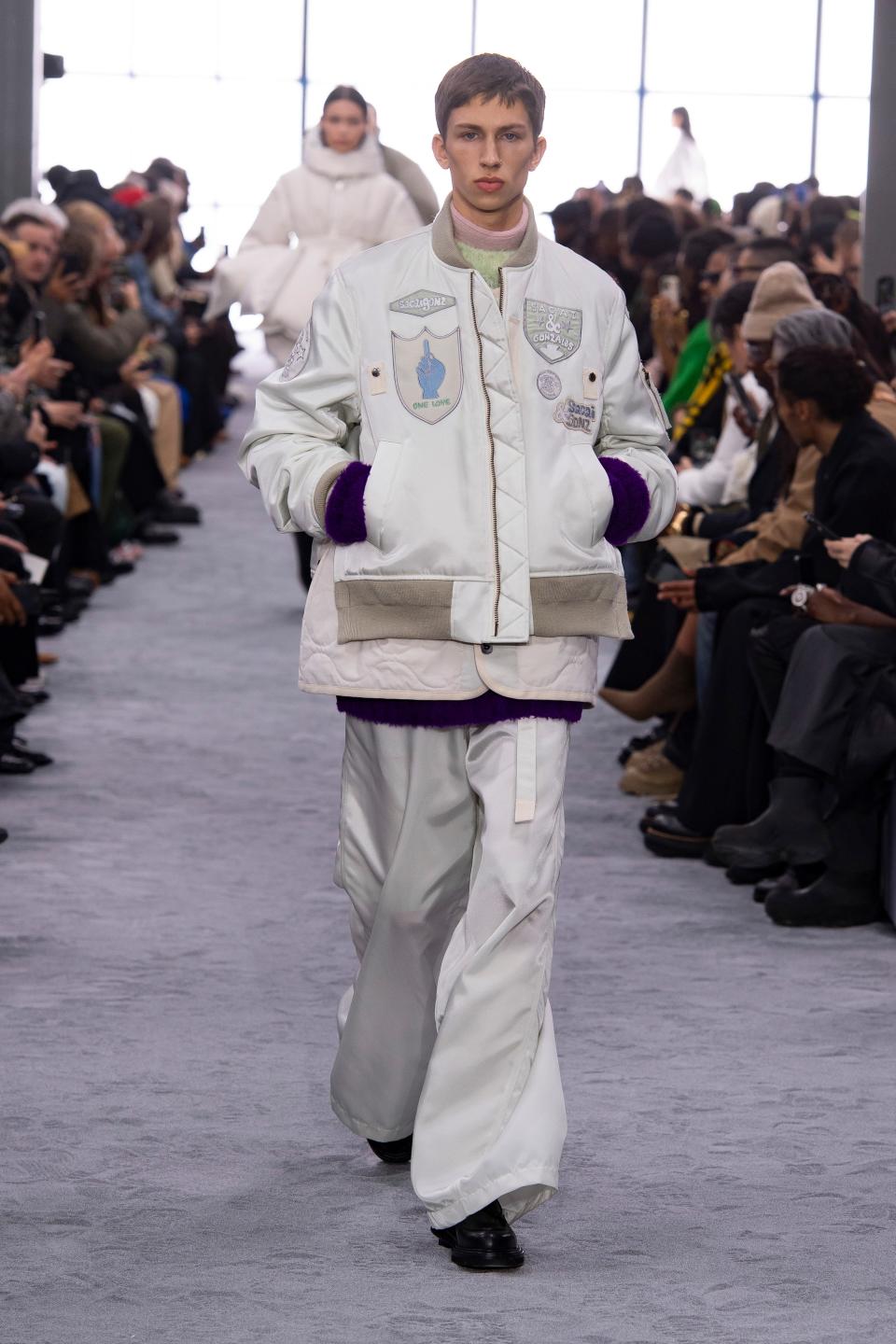
“I’m through the roof,” said Gonz, who seemed dazed by the scale of the 65-look production, which also included hybrid mackintosh coats and nylon bombers with the rounded arms of a vase, and tailored pleated skirts worn over matching trousers. “She takes things that are so simple and so known, like blazers and bomber jackets, and makes them incredible,” said Yotka. Her genius, Yotka added, is in how Abe “is able to add these utilitarian or technical details in a way that isn't clunky. You can stomp through the city in Sacai and just feel crazy and powerful.”
Backstage, I asked Abe how she knows when to stop designing a piece. Her work is so detailed and fascinating to look at but somehow never overdone or gimmicky. “It's a very good question,” she said, “but I simply design what I would wear. It's not just about the show. I want people to actually wear the clothes.” By that standard, on the streets of Paris and elsewhere, she is absolutely succeeding.
It’s the billion-dollar question of the season: How do you, as a fashion designer, get people to actually wear your clothes? This might sound painfully obvious, but I want to draw a distinction between this task and a related one, which is how to get people to buy your clothes.
During the pandemic-induced surge in online shopping and subsequent revenge spending on outfits for events and weddings and vacations, brands have recently had no problem with the buying part. The luxury industry broke free of gravity, and based on sales numbers, basically every designer looked like a genius. But now the industry is coming back down to earth as consumers return to their regular spending habits, and economic forecasters—the only trend forecasters who matter in fashion these days—are reporting stormy weather ahead. Which is to say nothing of the current state of global affairs, which caused Rick Owens to move his big-top show into his own home out of respect for what he called the “barbaric times” we live in.
Meanwhile, men’s relationship to clothing has continued to evolve. “I feel men are starting to kind of copy women’s shopping behavior,” Jockum Hallin of Our Legacy told me. “The guy will invest in the pieces that are shown and visible. But instead of a big fancy bag, maybe they’ll get a big coat.” Men are, in other words, increasingly discerning and tasteful, and expect to use the stuff they buy for years rather than resell it (which is increasingly challenging—there’s too much stuff!). Which all adds up to the fact that men’s fashion designers, expected to keep the growth party going, need to be more sophisticated and persuasive than ever.
Some designers proposed a return to classicism, and a few of Abe’s countrymen had the most novel visions for how to make tailoring and outerwear look dynamic and new. Junya Watanabe was so good that all the hungover editors who missed the 10:00 a.m. show grumbled for the rest of the week. Watanabe, who said via translator he “wanted to propose a new way of showing jackets,” tailored pant legs—trousers, khakis, and jeans of all varieties—onto the hems of blazers, creating an incredibly cool opera-coat shape out of mixed-up fabrics. There was an actual opera cape, too, made in collaboration with Palace, whose mark was embroidered on the back (another way to introduce elegance to a younger customer).
In between puffs of his cigarette, godfather of avant garde Japanese menswear Yohji Yamamoto explained that he is “looking forward, always.” Yamamoto is a dark figure, but the octogenarian’s show had a playfulness about it that may or may not have been intentional. The soundtrack included a smoky cover of Taylor Swift’s “Lover” by the designer himself, which was the best tune I heard all week. Yamamoto’s old buddy Wim Wenders also walked in the show, and Zinedine Zidane was in the house for the whole thing. Some of Yamamoto’s tailoring included painted pinup girls across the back, a nod to his archival work, but there was a sense of romance in the styling, and reminders of Yamamoto’s wicked humor (“I love Yohji, he is for sale” read the embroidery on a tan overcoat). “Man should be man,” he said backstage. But in a new way.
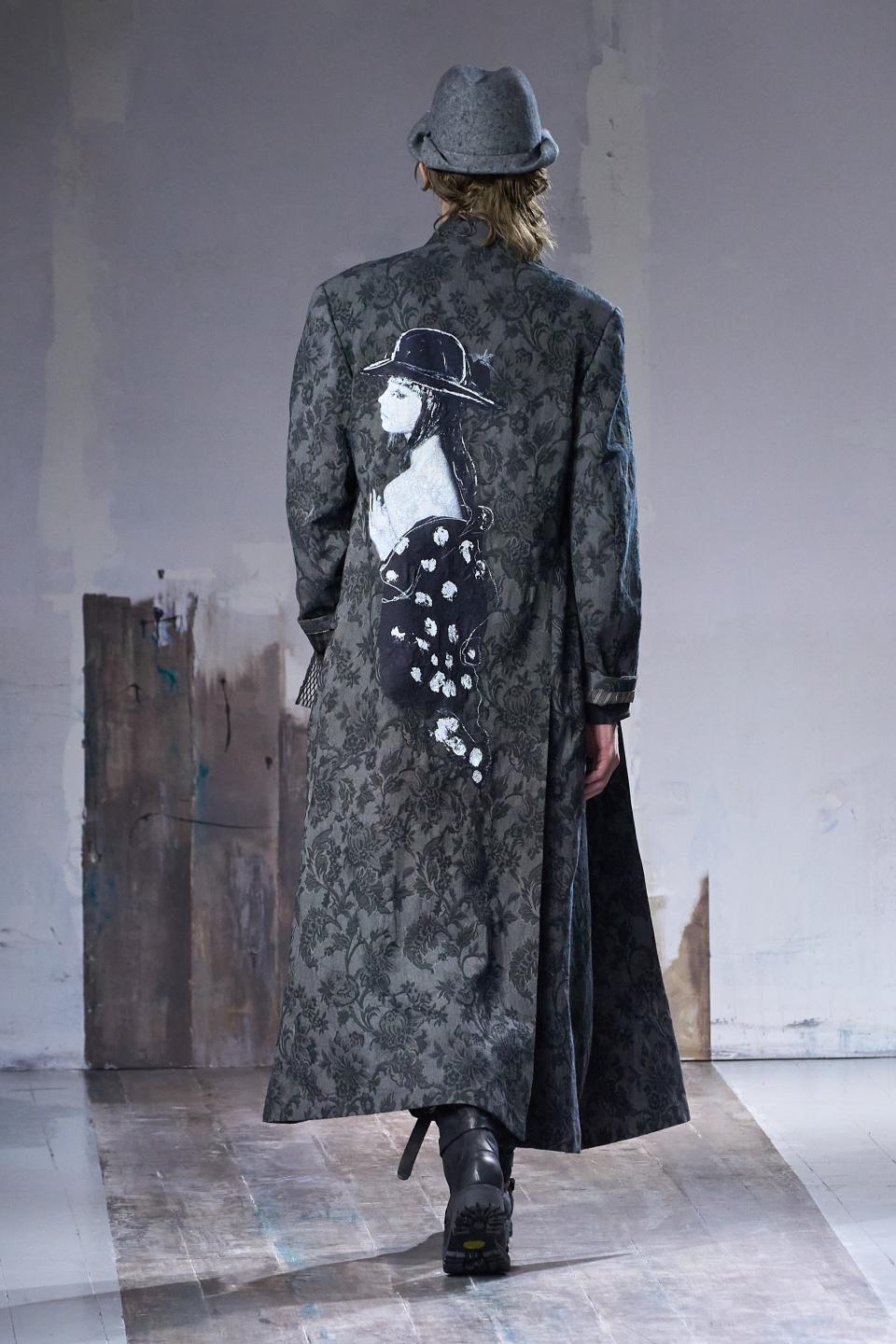
Yohji Yamamoto : Runway - Paris Fashion Week - Menswear Fall/Winter 2024-2025
Francois Durand / Getty Images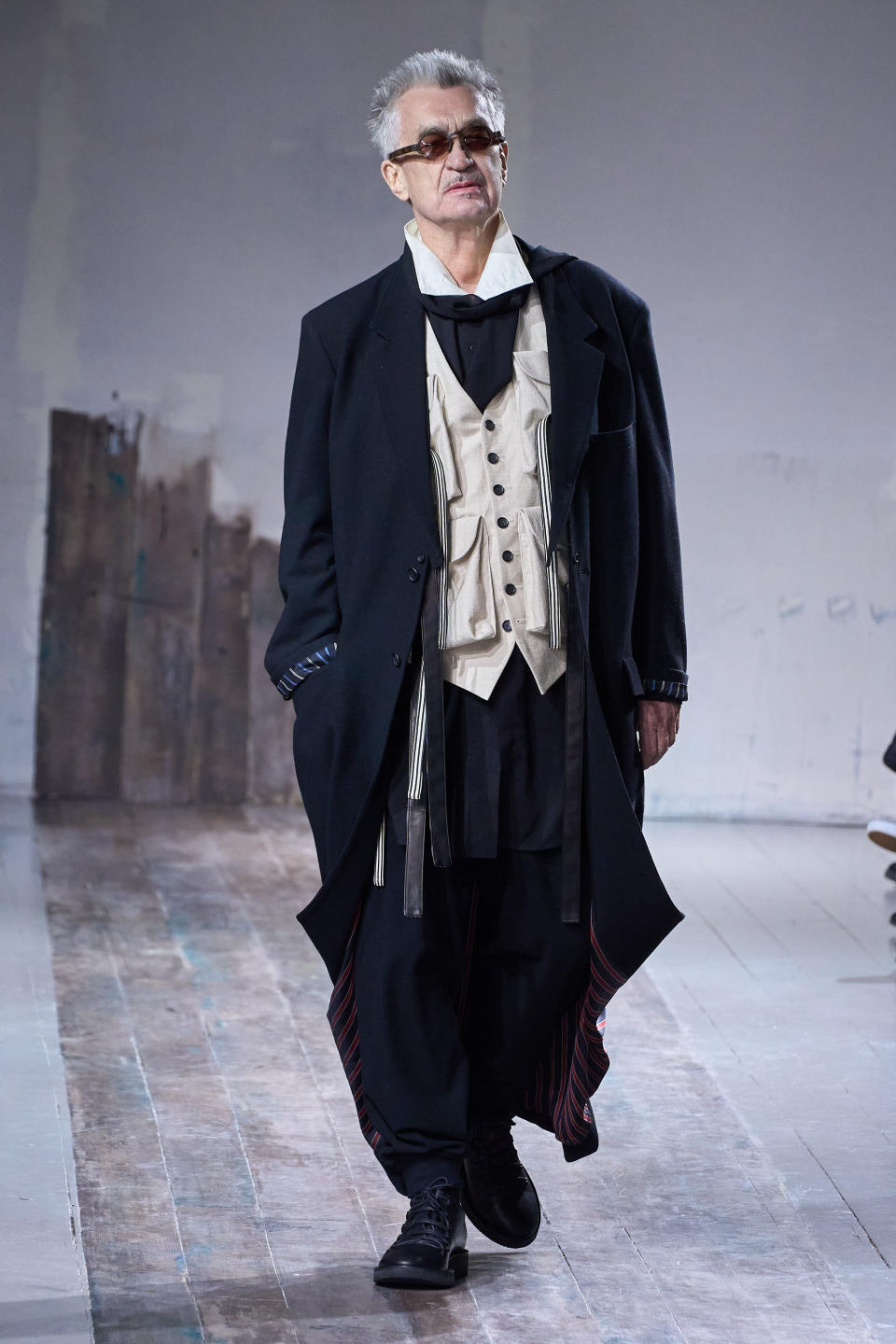
Auralee, the Tokyo-based brand by Ryota Iwai, had its PFW runway debut right before Louis Vuitton. What a palette cleanser before Pharrell opened the luxury firehose. Iwai makes all of his own fabrics, and Auralee’s simple wardrobe staples have a resounding depth to them. But I was most captivated by the casually bonkers styling, which made me think Auralee is the closest thing men have to Miu Miu. Sweaters became balaclavas and scarves (a move I and many others tried to copy in frigid Paris the rest of the week), and the unexpected but deeply satisfying color combinations could be taught in fashion school. The whole thing made me think of the little ingenious details in an outfit that might make a stranger on the street or across a restaurant think about you for the rest of the day.
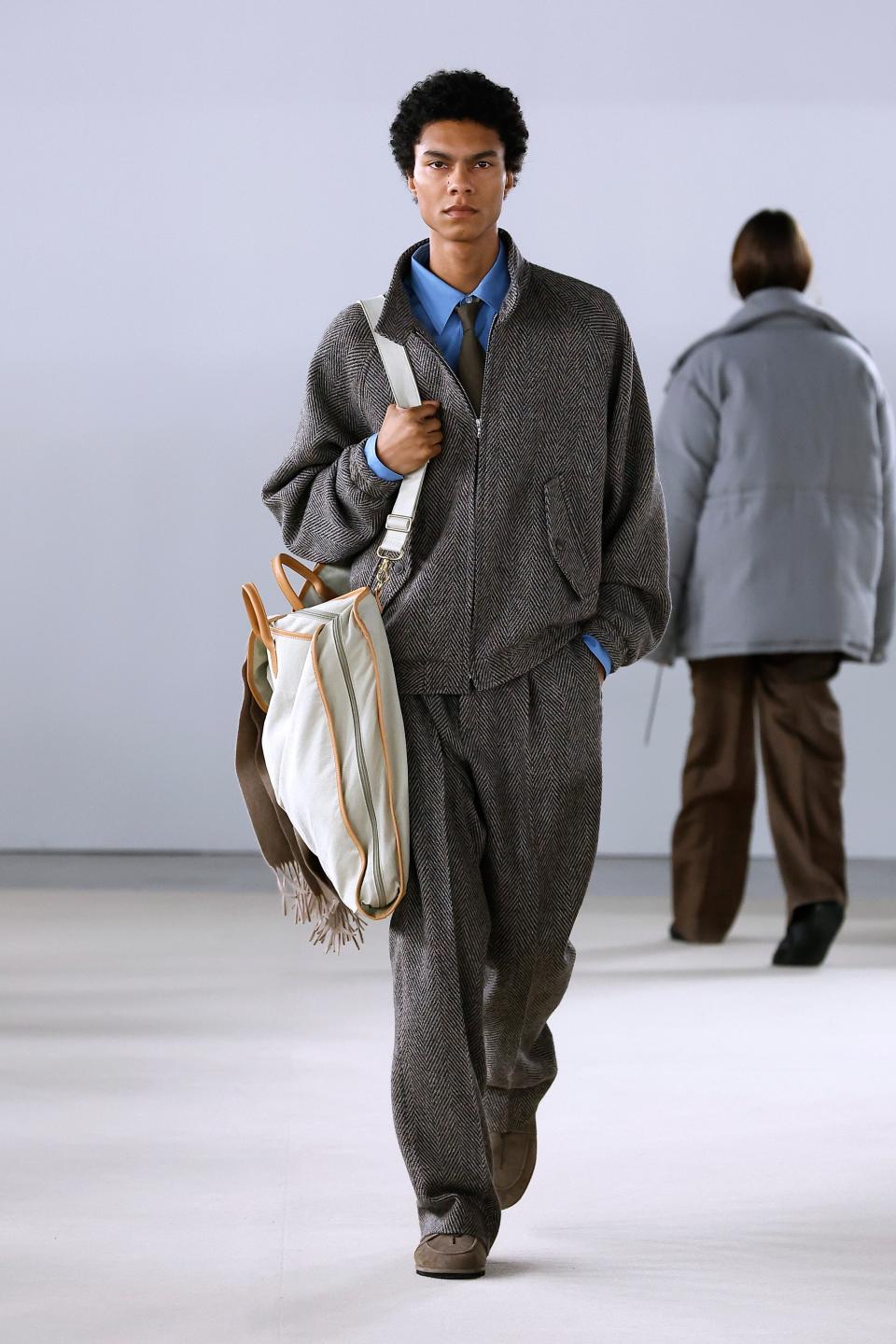
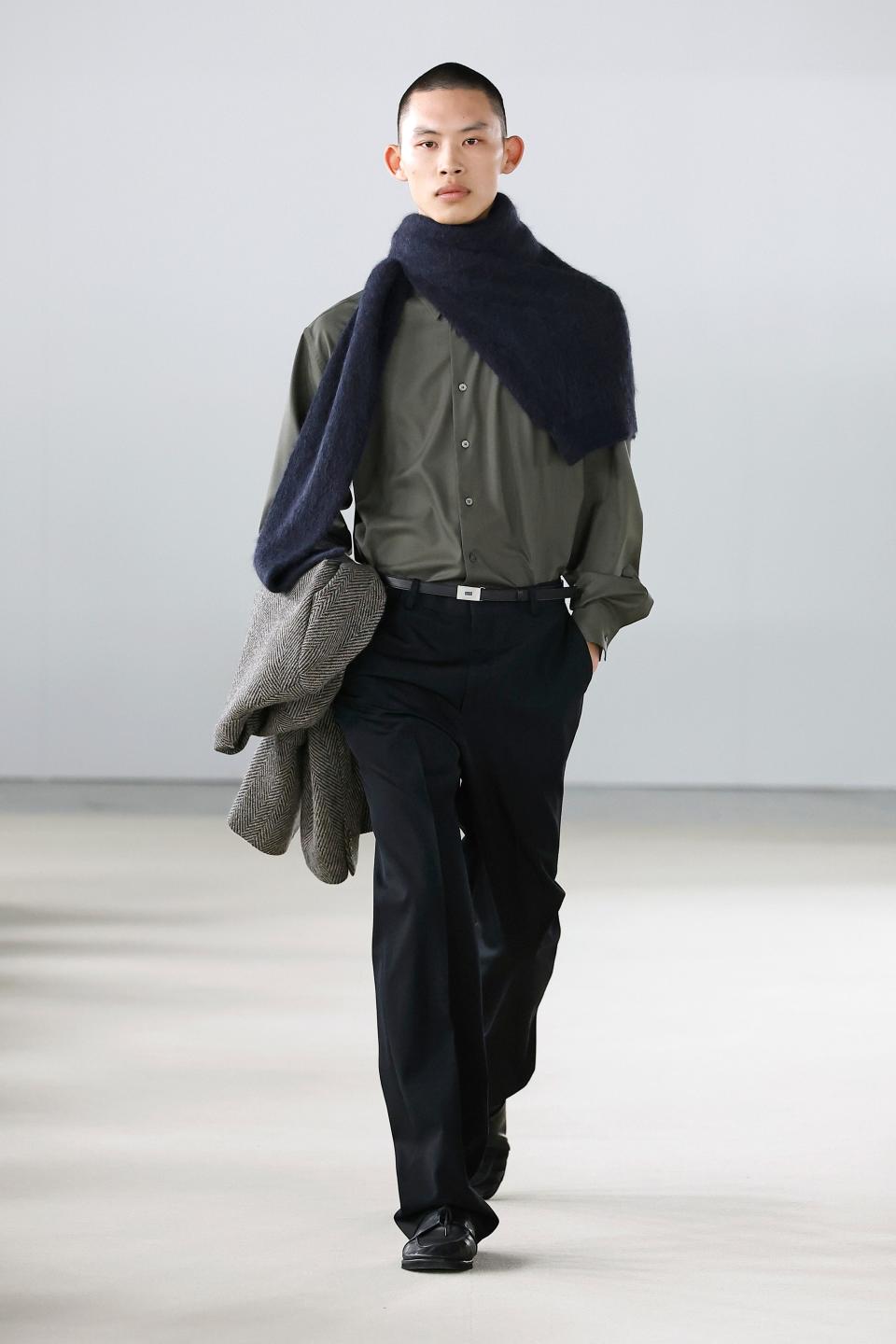
Other designers responded to our uncertain moment by playing their hit singles. Kiko Kostadinov collections usually contain layers of references to art and antiquity so dense that they make Prada’s famously obtuse show notes look like light reading. On Saturday, the designer referenced his excellent and always-intriguing previous work for the first time, reviving highly sought-after (and like all his work, ingeniously constructed) zip-up tops from his early collections, as well as new versions of grail-tier chenille hoodies, this time as languid turtlenecks. Darting on the “pretty complicated” shoulders of tailored jackets and the sides of refreshingly slim trousers created a “K.”
“I’m playing with the idea of branding through construction rather than through a logo or application,” said Kostadinov, who also unveiled a pair of collaborative Levi’s jeans that will be recognizable on the legs of the designer’s many devoted superfans. Maria and Joerg Koch of magazine-plus-fashion-line 032c meanwhile presented a physical manifestation of fashion fan-fic for a young and obsessive crowd at their first runway show. The Berlin-based Kochs have attended hundreds of these things, and theirs was a total blast, with hip-swinging appearances by cool-kid supermodels Mona Tougaard and Paul Hameline and tough (in a good way, very Berlin) flight jackets and nylon trousers.
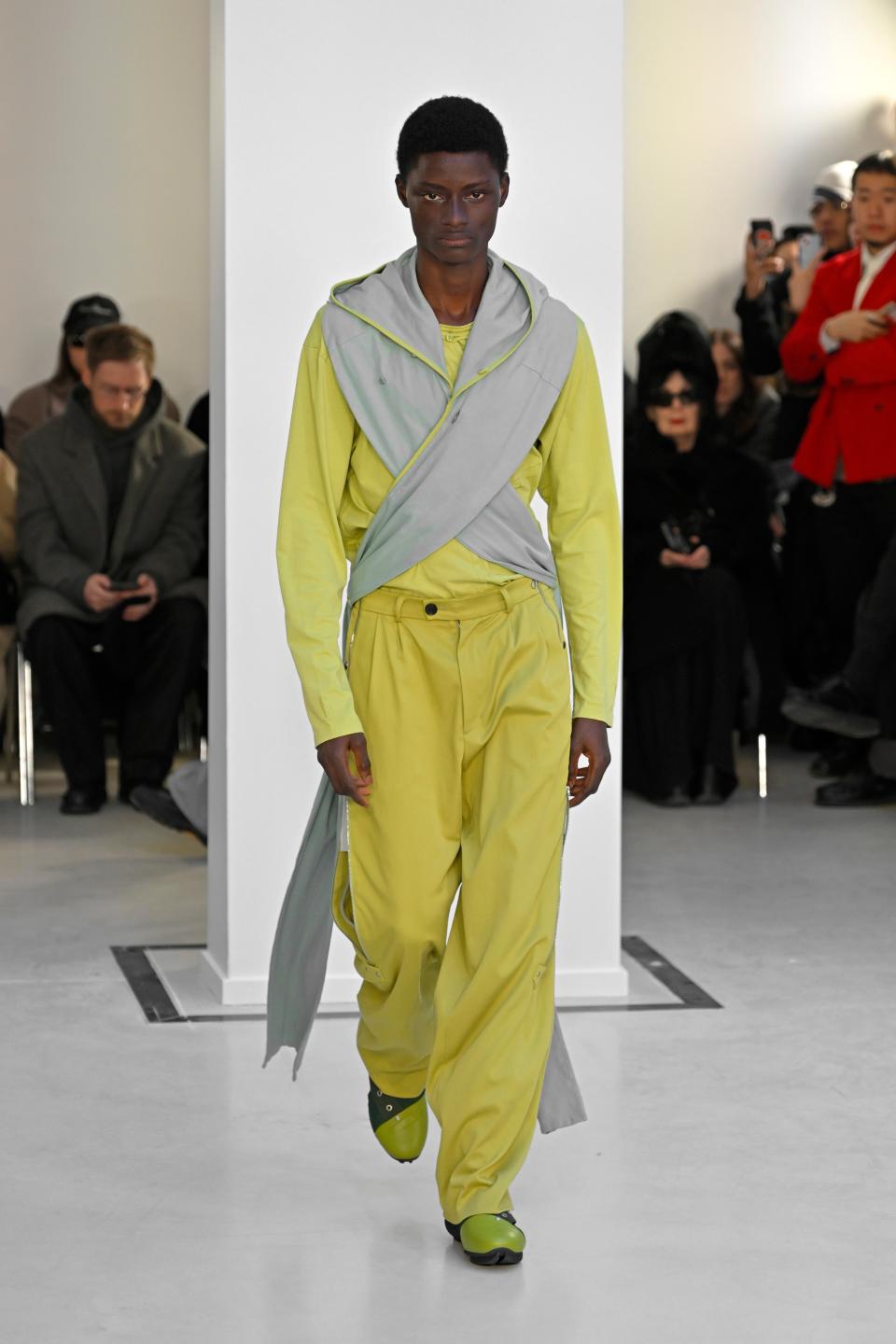
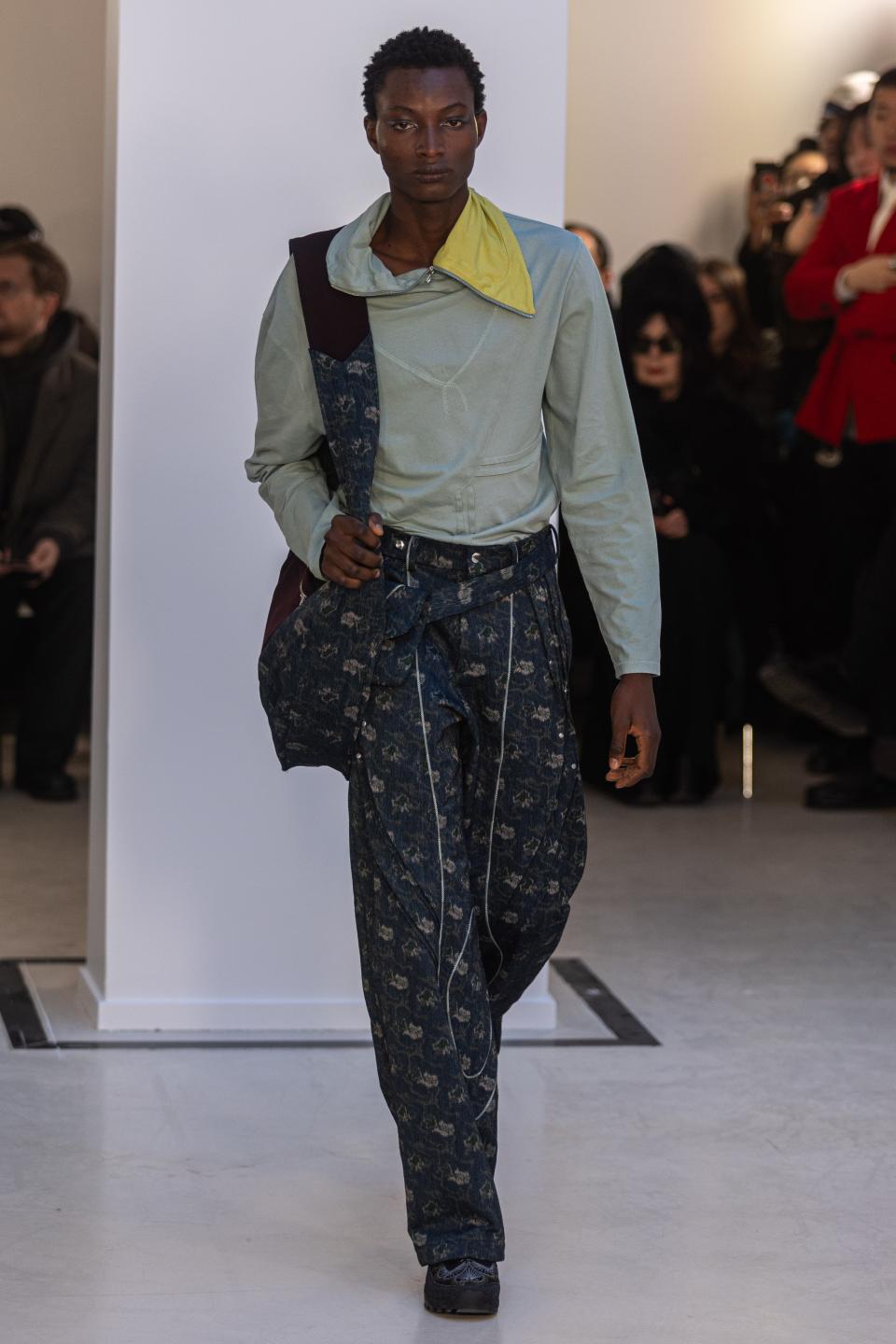
At Dior Men and Hermès, it was hard to ignore a sense of unbridled confidence on the parts of, respectively, Kim Jones and Veronique Nichainian. Both creative directors are playing with hot hands at houses that cover the highest-end of the luxury market, where sales figures are still strong. Jones had already wowed the crowd with his first act, a balletic version of the casual-luxury formula he has perfected at Dior inspired by his Nureyev-linked uncle, Colin Jones. Then came the real fireworks when Jones unveiled his first Dior Men’s couture collection, almost two dozen looks of escalating regality that included a silvery kimono handmade in Kyoto and a crocodile tunic, not to mention piles of diamond jewelry. For attendees it was pure couture porn, and for princelings everywhere it was next season’s shopping list. Meanwhile at Hermès, the long-tenured Nichainian poured on the opulence with a quartet of slim (almost skinny) tailored pieces made in satiny pony hair, chic but wow-inducing.
If there’s a specific trend of the season, it’s the return of skinny trousers on an unholy wave of indie sleaze. But of course, as Loewe’s Jonathan Anderson pointed out in a post-show huddle, fashion trends don’t quite operate the way they used to. “In fashion we used to be like, It’s about this movement that is happening,” he said to a group of journalists. Anderson doesn’t think that works anymore. Sure there were cowboys at Vuitton and turquoise punctuating Valentino and bolo ties at Lemaire, too, but it’s not like we’re in for a proper wild west revival. Trends have been washed away by pure content. And Anderson is the closest thing we have to a content couturier. “We are just the Internet,” he said. “The idea that now that media has become a 360, what does that mean about the future of fashion and how we put clothing together?”
It was fun to watch Luca Guadagnino and the rest of the stacked celebrity front row furrow their brows as they tried to decode Anderson’s answer in the form of pervy unbuckled jeans and Onlyfans-ish open bathrobe coats, the belts repurposed as flouncy bow-scarves, especially with a soundtrack that featured a naughty interview with a young and dangerous Sean Penn. It was even more fun to listen to Anderson decode it himself. Anderson was proposing a “forced look,” with shoes attached to socks, socks attached to trousers, and trousers attached to jackets, a reaction to the algorithm-driven fashion free-for-all that’s both freeing and overwhelming. Anderson is a master at making work both in dialogue with and for our chaotic reality. “The goal of fashion is ultimately to predict the future,” he said. “But sometimes look at it and go, I'm going to reinterpret the norms, but by using trickery.”
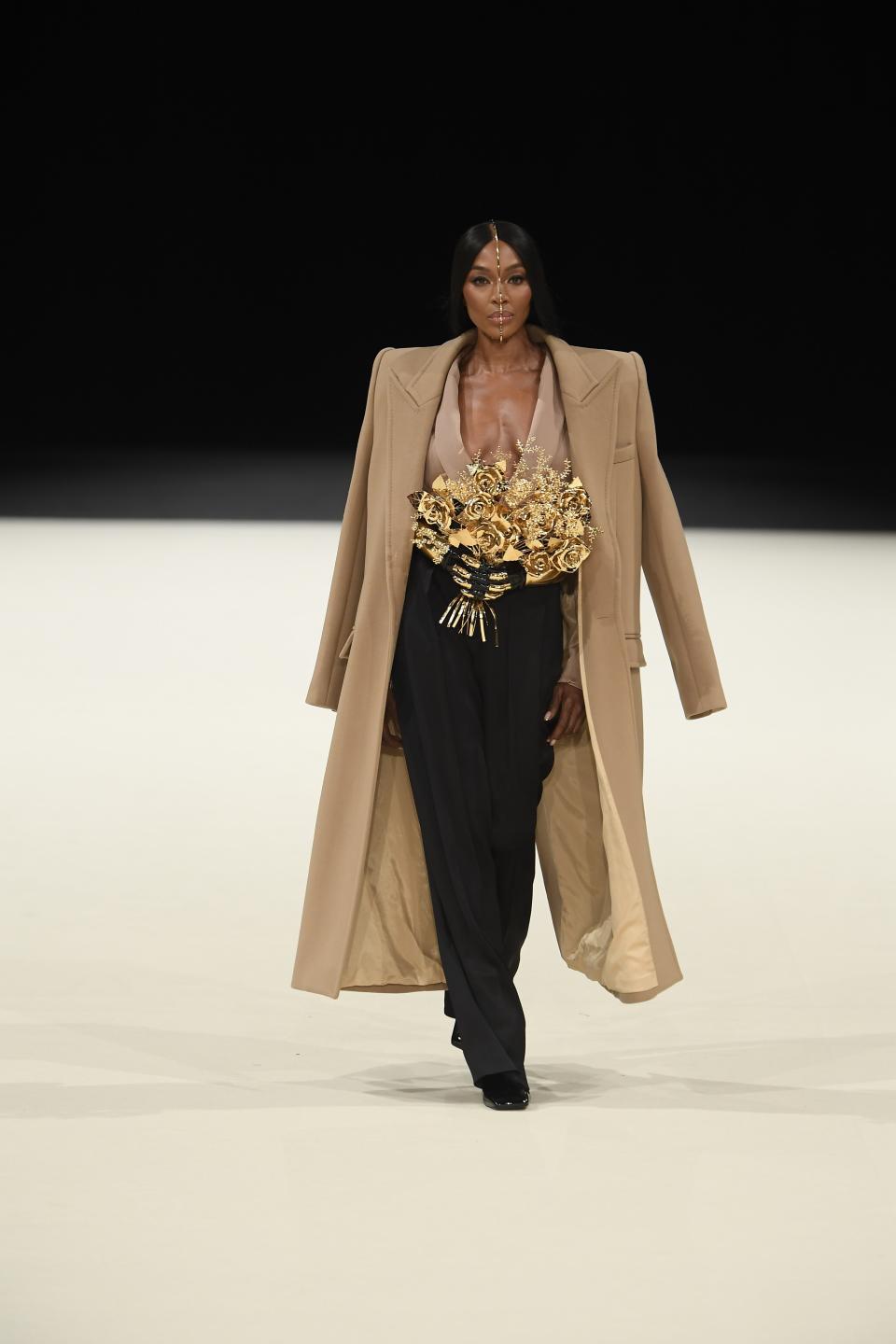
Finally, at his first Balmain Homme show in four years, Olivier Rousteing offered his own take on how to transcend what’s left of fashion’s pendulum swing. “Some are really into quiet luxury, but we're screaming luxury,” he said. Since joining Balmain in 2011, annual revenues have increased from $20 to $300 million, and never once in that time has Balmain reflected the prevailing tastes of the moment. Which is exactly his secret. ‘“I don't care about bringing you a beige cashmere coat or a beige turtleneck,” he said.
There was a beige cashmere coat in the final look, but it was worn by Naomi Campbell—nothing quiet about that. To his devoted client, Balmain is synonymous with fashion and that’s the end of it. Rousteing got the first and last standing ovation I saw all week when Campbell led out his cast of willowy flaneurs, their halfback-shouldered jackets covered in polka dots and unmissable graphics made by Accra-based artists Prince Gyasi. The new Balmain man, Rousteing said, “is joyful, confident, and not scared of being judged. He is a man that is feeling free, and freedom is so important.”
It was a standout moment, about as over-the-top as Chitose Abe’s own triumph was subtle and organic. But both designers understand exactly what their customer will be obsessively wearing—not just buying—six months from now, storm clouds be damned.
See all of our newsletters, including Show Notes, here.
Originally Appeared on GQ

